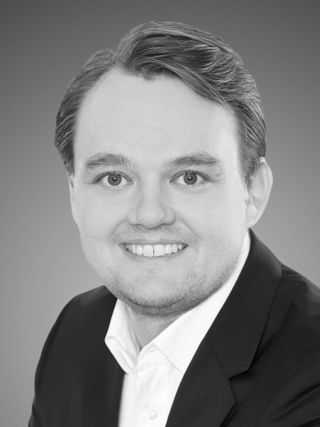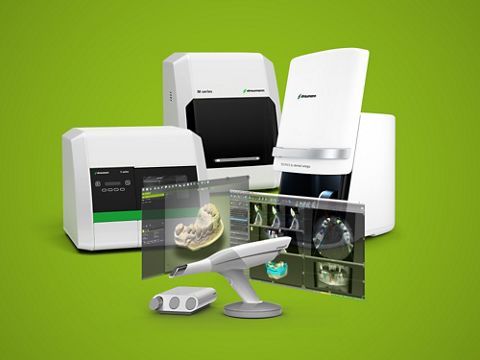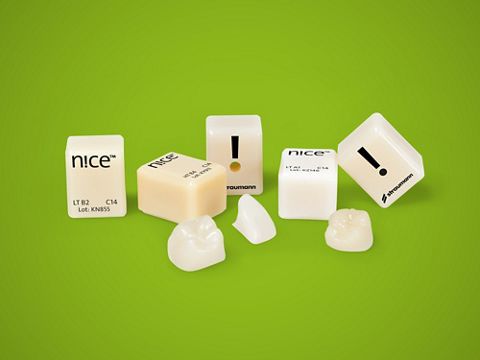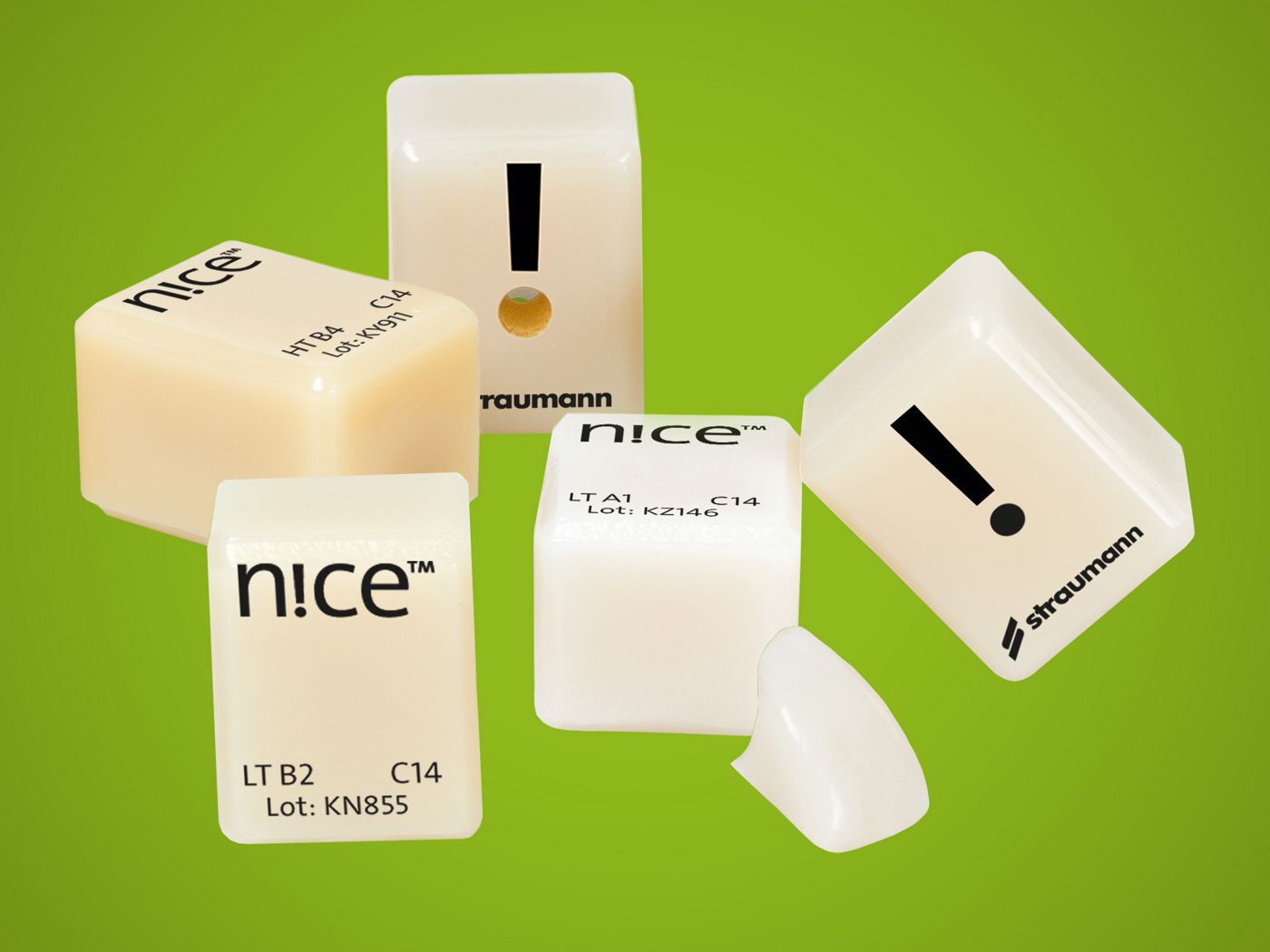Grind, polish, done! Indirect procedures in the dental workflow
A clinical case report by Johannes Beiter, Germany
Workflows and procedures in practice are changing as a result of the increasing establishment of computer-assisted dentistry in prosthetic therapy and the growing diversity of materials. The possibility of chairside fabrication is improving both patient comfort and productivity. A new interesting material for single-tooth restorations is the Straumann® n!ce® glass-ceramic. The material is presented by the author based on a patient case.
Safety, comfort and esthetics – these primary wishes of the patient for prosthetic treatment are joined by the need for an efficient treatment process, high economic efficiency and a small number of therapy sessions. Thanks to the possibilities offered by CADCAM-assisted fabrication, these aspirations have in many cases been fulfilled. While a dental technician is indispensable for complex and esthetically demanding restorations (e.g. in the anterior region), single-tooth restorations (e.g. inlays, partial crowns, crowns) can in many situations be realized within the dental workflow. For the patient this has the great advantage – among others – that only one therapy session is needed. Various materials are suitable for such an indication. Mainly, these are materials from the large family of glass-ceramics, which in combination with the adhesive technique optimally fulfill the requirements for conservation of dental hard tissue, biocompatibility, stability and esthetics.
Overview of dental ceramics in everyday clinical practice
The diversity of materials in everyday prosthetic practice is constantly increasing, especially within dental ceramics. For the practitioner it is important to maintain the overview in order to select the optimal material for the indication. Dental ceramics can be broadly divided into ceramics with a glass phase (e.g. silicate ceramics, glass-infiltrated ceramics) and ceramics without a glass phase, the oxide ceramics (e.g. zirconium oxide). Differences exist in, among other things, the photo-optical properties and the material characteristics (e.g. flexural strength, fracture toughness). For single-tooth restorations to be performed chairside, a high-strength glass-ceramic is often used, such as lithium (di)silicate ceramic or lithium silicate ceramic. To obtain the final strength level of 360 to 400 MPa, these ceramics are crystallized after grinding. There are also pre-crystallized blanks which only need to be polished. However, in this case the strength is greatly reduced. For several months, the family of CADCAM glass-ceramics has been supplemented by a further class of materials: lithium alumosilicate ceramics (Straumann n!ce).
Precrystallized and high strength
In terms of material science, the Straumann fully crystallized glass-ceramic is a lithium disilicate reinforced with lithium aluminosilicate. The flexural strength is 350 MPa (+/- 50). Its great advantage is its easy and efficient processability. The range contains blanks in two translucency levels: HT (High Translucency) and LT (Low Translucency). Both translucency levels are available in different color nuances (Bleach, A1, A2, A3, B2 and B4 of the VITA Classical tooth color ring) and cover a large number of restorations in everyday clinical practice. The fully crystallized milling blocks were developed specially to fabricate crowns, partial crowns, inlays, onlays and veneers. The blanks are compatible with different block holders for different milling machines (Fig. 1). The glass-ceramic blocks can therefore be processed with conventional milling machines and require no investments in additional hardware or software. The material can be ground, polished and used without crystallization firing. This saves time and effort in daily practice. Individual characterization is possible if required.
Patient case
Initial situation
The patient wished to have the large-surface amalgam fillings in the upper and lower jaw removed (Fig. 2-3). He wished to have fully ceramic restorations that can be created with the smallest possible effort. These are single-tooth restorations (partial crowns). In the upper posterior region a bridge restoration was indicated, which was implemented with lithium disilicate ceramic. All other indirect single-tooth restorations had to be performed with Straumann n!ce. The material is biocompatible, and relatively strong without additional crystallization firing, while featuring natural photo-optical properties.
Preparation
The aim was new minimally invasive treatment within the dental workflow. No functional disorders were present. No periodontal abnormalities were identified either. A vitality test was performed on all teeth with a positive result, up to tooth 46. This tooth underwent root canal treatment.
After the anesthesia and fitting of the rubber dam, the amalgam fillings were removed and the teeth were prepared in a minimally invasive way for full ceramic restorations (Fig. 4-6). The precondition: Rounded design, no corners or sharp edges, shoulder preparation with rounded edges and/or hollow groove. The manufacturer specifies 1 mm as the minimum layer thickness for crowns and partial crowns, which was complied with in the preparation.
Construction and grinding
The situation was “molded” or scanned respectively with the intraoral camera. To prevent mirror images or undesired reflections, the teeth first had to be dried to the maximum extent. This was followed by buccal bite registration (scan) and importation of the data into the CAD software.
The scans were checked and artifacts were removed. After the virtual model calculation and assignment of the jaws with the bite register, the preparation boundary could be easily marked and the insertion axis defined with a few clicks. The automated, biogeneric initial suggestion of the software was a valuable aid in constructing the restorations. Only minor changes were made to the initial suggestion. The restorations were constructed within a short time (Fig. 7-8) and the data were transferred to the CAM machine. In the milling preview, the design was finally checked, e.g. for values below the minimum wall thickness. The precrystallized n!ce was now fixed and the restorations were ground (Fig. 9). Milling was performed in the fine mode and lasted about 25 minutes.
Completion
After removing the ground restorations from the machine, the grinding pins of the blank were removed with a fine grain diamond. The restorations ground from n!ce showed finely tapered margins and a 1:1 reproduction of the construction. On trial placement in the mouth, the fit was judged as very good. At some sites the approximal contact points were adjusted as required. Final polishing of the restoration outside the mouth produced a high gloss finish. For a natural appearance, the n!ce restorations can be polished with a standard polishing set for lithium disilicate glass-ceramic. A classical polishing protocol was used in this case - coarse burs, ceramic polisher, zirconium oxide polishing paste and brushes (Fig. 10) - and the restorations were then cleaned in an ultrasonic bath. The crowns and partial crowns were ready to be fitted. An additional crystallization firing as for comparable materials is not necessary for n!ce.
Insertion
The insertion of restorations in the mouth was performed with adhesive attachment under rubber dam. The same adhesive securing cements can be used for n!ce as for lithium disilicate. Before insertion, the ceramic restorations were cleaned with phosphoric acid (30 seconds). Conditioning of the adhesive surface was performed per protocol with 20-second etch bonding (5% hydrofluoric acid gel). After cleaning and conditioning the teeth, final insertion of the restorations was performed (Fig. 11-12) and the functional criteria underwent a final check. The two small amalgam fillings in teeth 34 and 35 were exchanged for direct composite fillings.
Conclusion
In combination with the intraoral scanner and the chairside CAM machine, Straumann n!ce glass-ceramic offers the possibility of fabricating indirect single-tooth restorations easily, safely and comfortably within the dental workflow. The lithium alumosilicate ceramic is supplied in the fully crystallized state. No crystallization firing is necessary. Grind, polish, done – the procedure described offers high comfort for the patient and high productivity in everyday practice.



